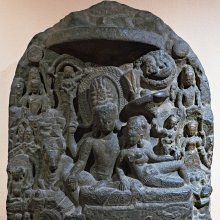Pir, Pīr: 4 definitions
Introduction:
Pir means something in the history of ancient India, Tamil. If you want to know the exact meaning, history, etymology or English translation of this term then check out the descriptions on this page. Add your comment or reference to a book if you want to contribute to this summary article.
Images (photo gallery)
India history and geography
Source: Shodhganga: A translation of Jhaverchand Meghanis non translated folk talesPir refers to “Muslim Saint”.—It is defined in the glossary attached to the study dealing with Gujarat Folk tales composed by Gujarati poet Jhaverchand Meghani (1896-1947)

The history of India traces the identification of countries, villages, towns and other regions of India, as well as mythology, zoology, royal dynasties, rulers, tribes, local festivities and traditions and regional languages. Ancient India enjoyed religious freedom and encourages the path of Dharma, a concept common to Buddhism, Hinduism, and Jainism.
Languages of India and abroad
Kannada-English dictionary
Source: Alar: Kannada-English corpusPīr (ಪೀರ್):—[verb] = ಪೀರು [piru]1.
Kannada is a Dravidian language (as opposed to the Indo-European language family) mainly spoken in the southwestern region of India.
Tamil dictionary
Source: DDSA: University of Madras: Tamil LexiconPīr (பீர்) noun [K. hīr.]
1. Sponge-gourd. See பீர்க்கு. [pirkku.] (தொல். எழுத். [thol. ezhuth.] 363.)
2. A kind of tree; மரவகை. [maravagai.] (தொல். எழுத். [thol. ezhuth.] 363, உரை. [urai.])
3. Pale colour of a love-sick woman; பெண்டிர்க்குக் காம நோயாலுண்டாகும் பசலைநிறம். (சூடாமணிநிகண்டு) முலைகள் பீர்கொண்டதும் [pendirkkug kama noyalundagum pasalainiram. (sudamaninigandu) mulaigal pirkondathum] (தேவாரம் [thevaram] 835, 5).
4. Whiteness; வெளுப்பு. மனிசர்க் காகும் பீர் [veluppu. manisark kagum pir] (நாலாயிர திவ்யப்பிரபந்தம் திருவாய்மொழி [nalayira thivyappirapandam thiruvaymozhi] 1, 5, 8).
--- OR ---
Pīr (பீர்) noun cf. sphira.
1. Abundant flow; பெருக்கு. குருதி பீர்விட [perukku. kuruthi pirvida] (உபதேசகாண்டம் விபூதி. [upathesagandam viputhi.] 38).
2. Milk, flowing from a woman’s breast; முலைப்பால். (சூடாமணிநிகண்டு) [mulaippal. (sudamaninigandu)]
--- OR ---
Pīr (பீர்) noun < Urdu pīr.
1. Muhammadan saint; முகம்மதியப் பெரிய.ார். [mugammathiyap periyar.] Muhammadan usage
2. Shrine carried in procession by Muhammadans; முகம் மதியர் ஊர்கோலத்தில் எடுத்துச்செல்லும் சப்பரம். [mugam mathiyar urkolathil eduthuchellum sapparam.] (W.)
--- OR ---
Pīr (பீர்) noun < bhī. Fear; அச்சம். (சூடாமணிநிகண்டு) [acham. (sudamaninigandu)]
Tamil is an ancient language of India from the Dravidian family spoken by roughly 250 million people mainly in southern India and Sri Lanka.
Nepali dictionary
Source: unoes: Nepali-English DictionaryPir is another spelling for पीर [pīra].—n. 1. anxiety; trouble; anguish; 2. leader or sectarian leader of Muslims;
Nepali is the primary language of the Nepalese people counting almost 20 million native speakers. The country of Nepal is situated in the Himalaya mountain range to the north of India.
See also (Relevant definitions)
Starts with (+1057): Pir-gruj, Pir-piray, Pira, Pira pisi, Pira-mukampar, Pira-nun-mutintatu-tanutanpatutal, Pira-porulvaippu, Piraayamaram, Piracai, Piracakapittam, Piracalai, Piracalu, Piracam, Piracamam, Piracamcai, Piracanam, Piracankap-piracankamaka, Piracankapitam, Piracankayanam, Piracanki.
Ends with: Kappir, Oppir, Sarpir, Vankapir.
Full-text (+37): Pir-piray, Cirakhi, Pirtanku, Ronkhanem, Pirvitu, Pirotu, Pirpu, Peer review, Piray, Peer, Sarpiranna, Tehalya, Penkalai, Pirenal, Tonkavanem, Samajodi, Tankunan, Heriya, Talaippiri, Pinkucam.
Relevant text
Search found 61 books and stories containing Pir, Pīr, Peer; (plurals include: Pirs, Pīrs, Peers). You can also click to the full overview containing English textual excerpts. Below are direct links for the most relevant articles:
Jalaluddin < [March-April, 1930]
A Rainy Night < [January – March 1992]
The Ritual of Sunset < [April – June, 2001]
Lord Jhulelal: An Analytical Study (by Thakkar Harish Gopalji)
Part 17 - Religious and Social pattern < [Chapter 2 - Literature Review]
Part 11 - Encyclopaedias < [Chapter 2 - Literature Review]
Part 9 - Philately < [Chapter 2 - Literature Review]
Manusmriti with the Commentary of Medhatithi (by Ganganatha Jha)
Verse 8.387 < [Section XLVII - Summing up of the Sections relating to Criminal Law]
Tiruvaymoli (Thiruvaimozhi): English translation (by S. Satyamurthi Ayyangar)
Pasuram 1.5.8 < [Section 5 - Fifth Tiruvaymoli (Vala el ulakil mutalaya)]
Rivers in Ancient India (study) (by Archana Sarma)
10. The river Puruṣṇī or Ravi or Irāvatī and its present status < [Chapter 6 - Changing trends of the Rivers from Vedic to Purāṇic Age]
13. The river Vitastā or Jhelum and its present status < [Chapter 6 - Changing trends of the Rivers from Vedic to Purāṇic Age]
9. The river Chenāb or Asiknī and its present status < [Chapter 6 - Changing trends of the Rivers from Vedic to Purāṇic Age]
Parables of Rama (by Swami Rama Tirtha)
Story 133 - The Wrong Way of Instruction < [Chapter XX - Sin]
